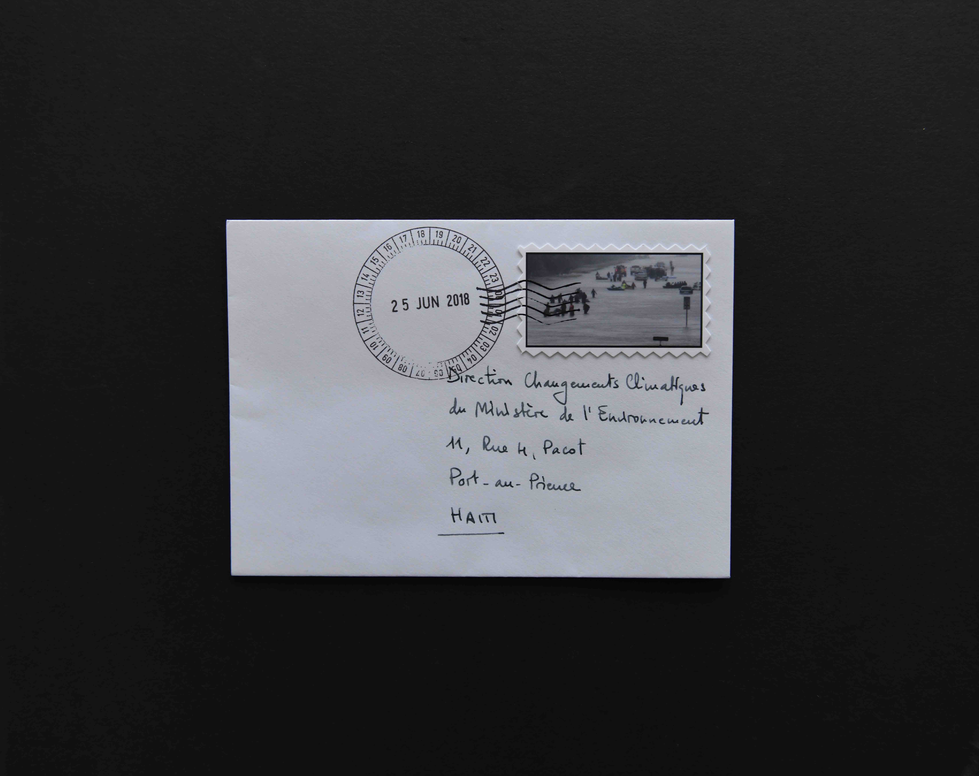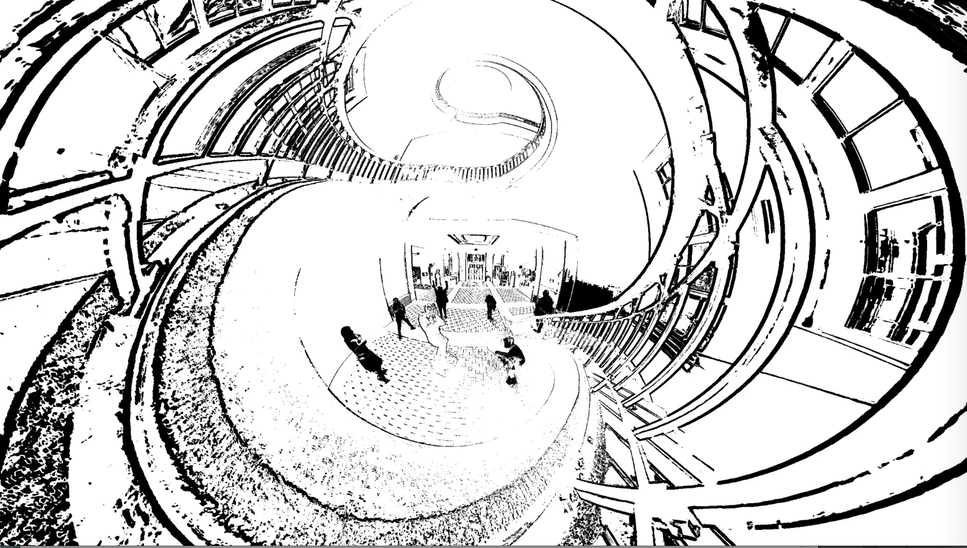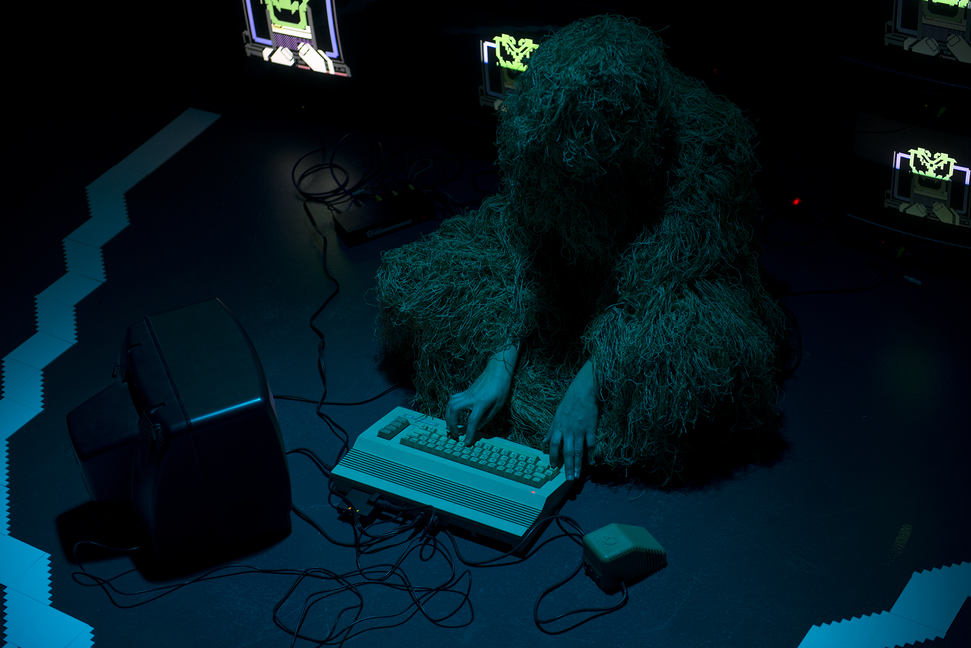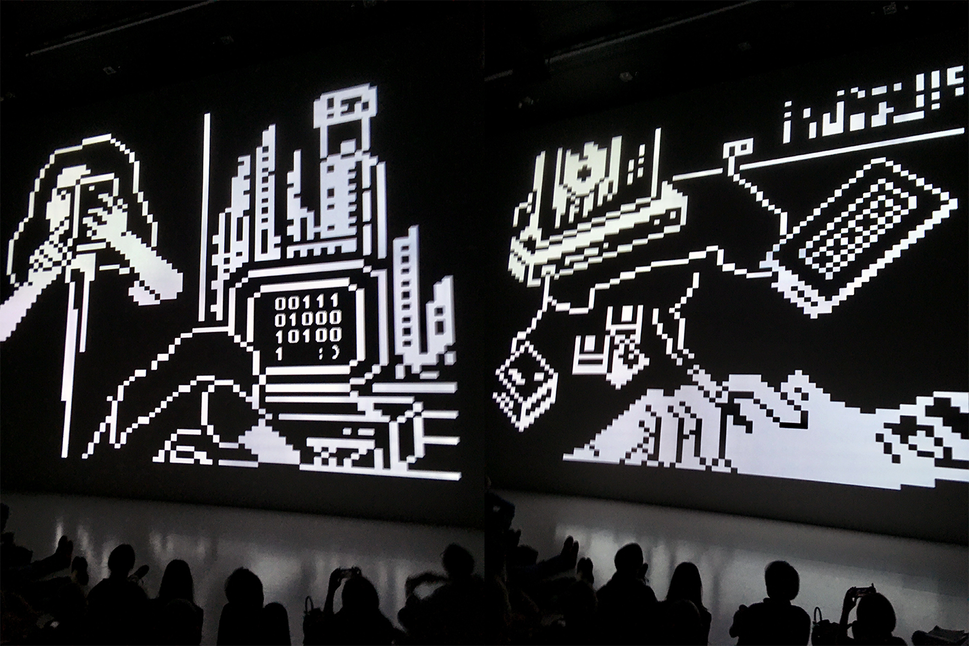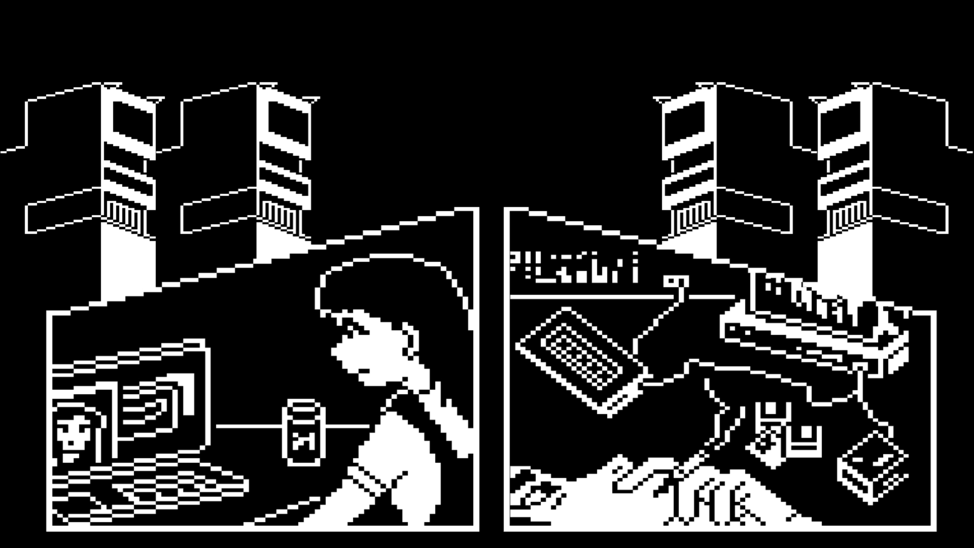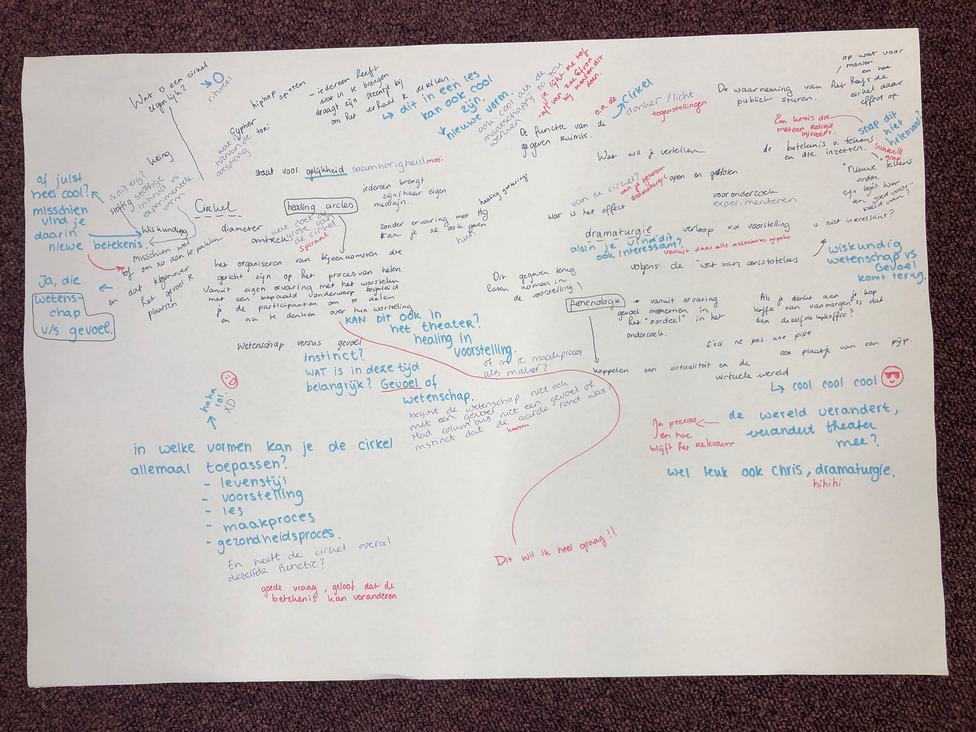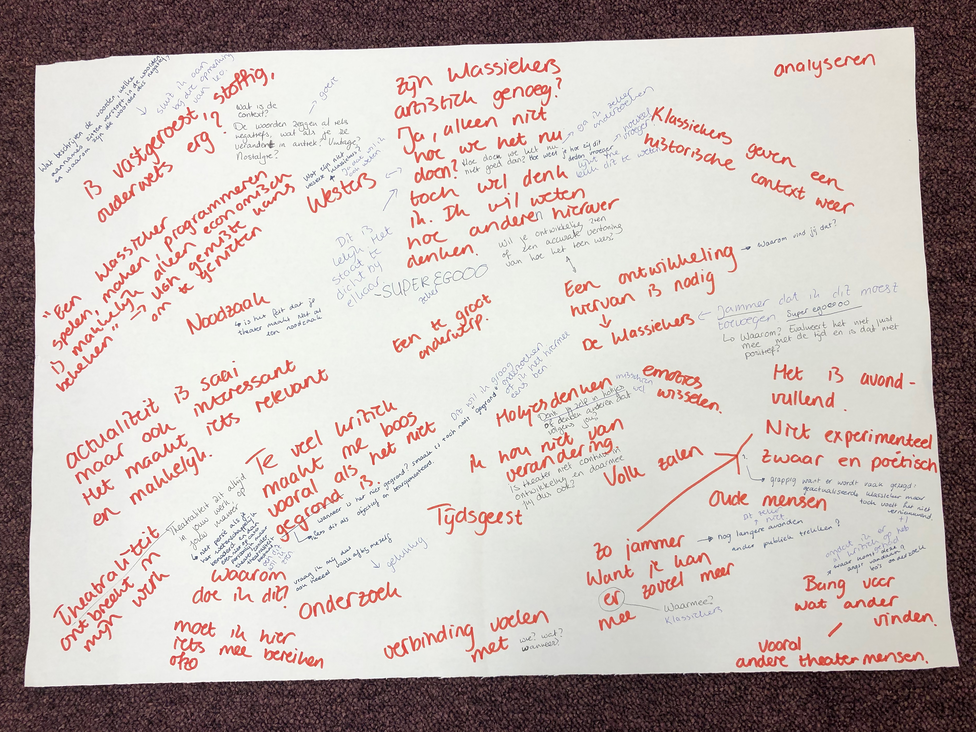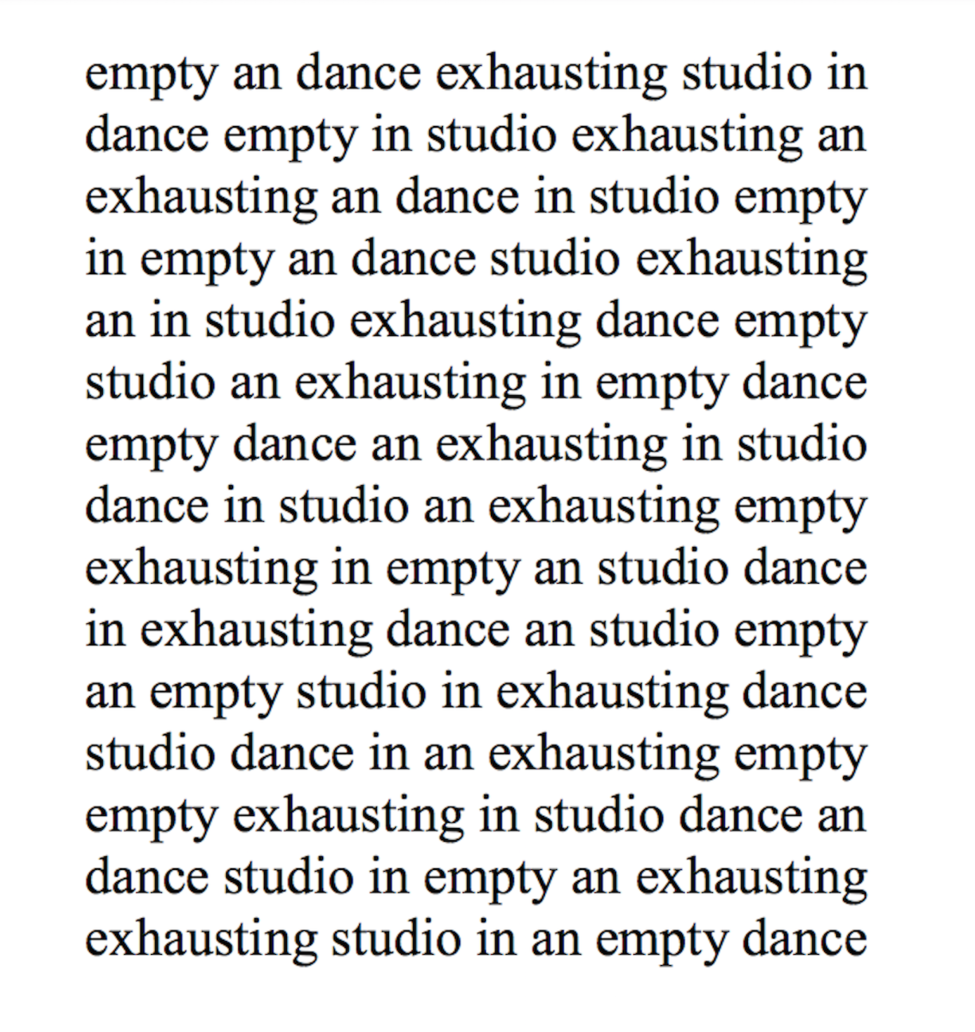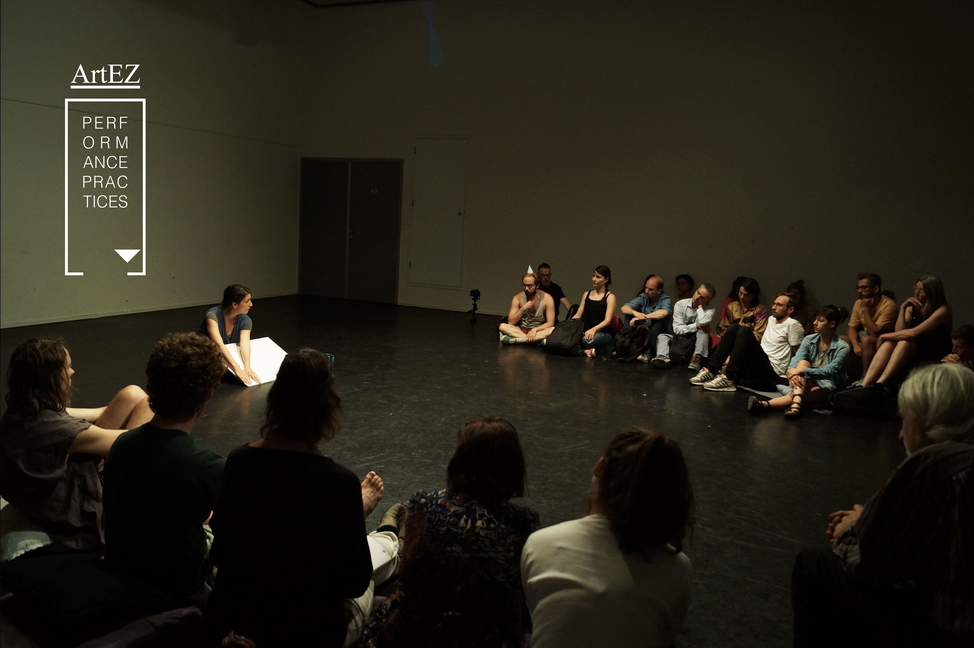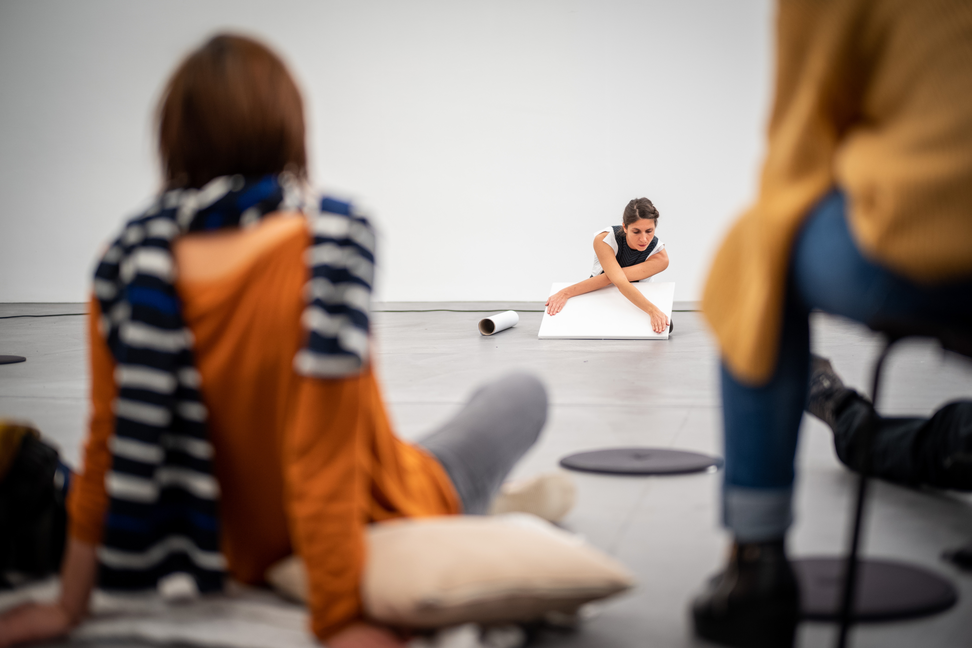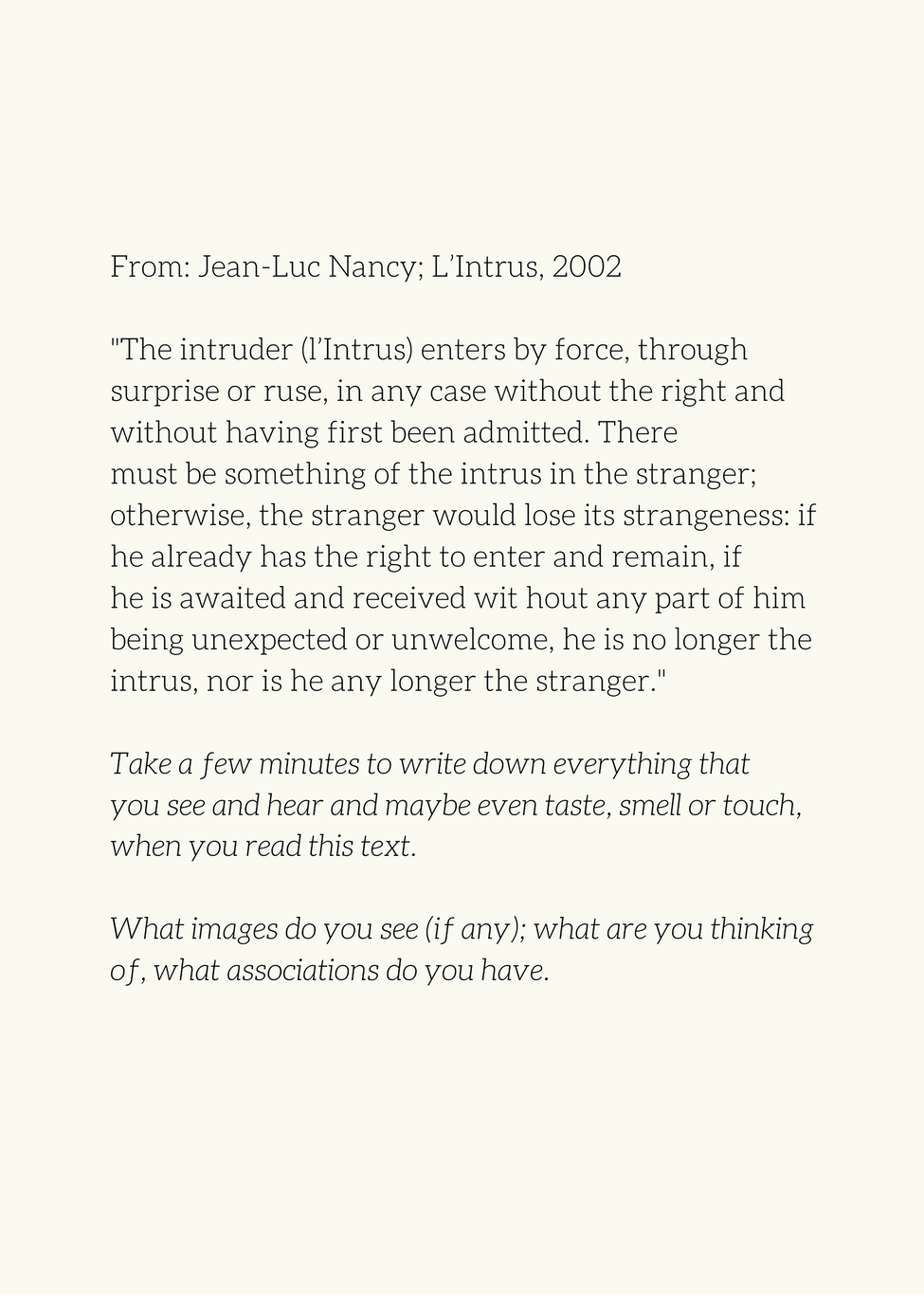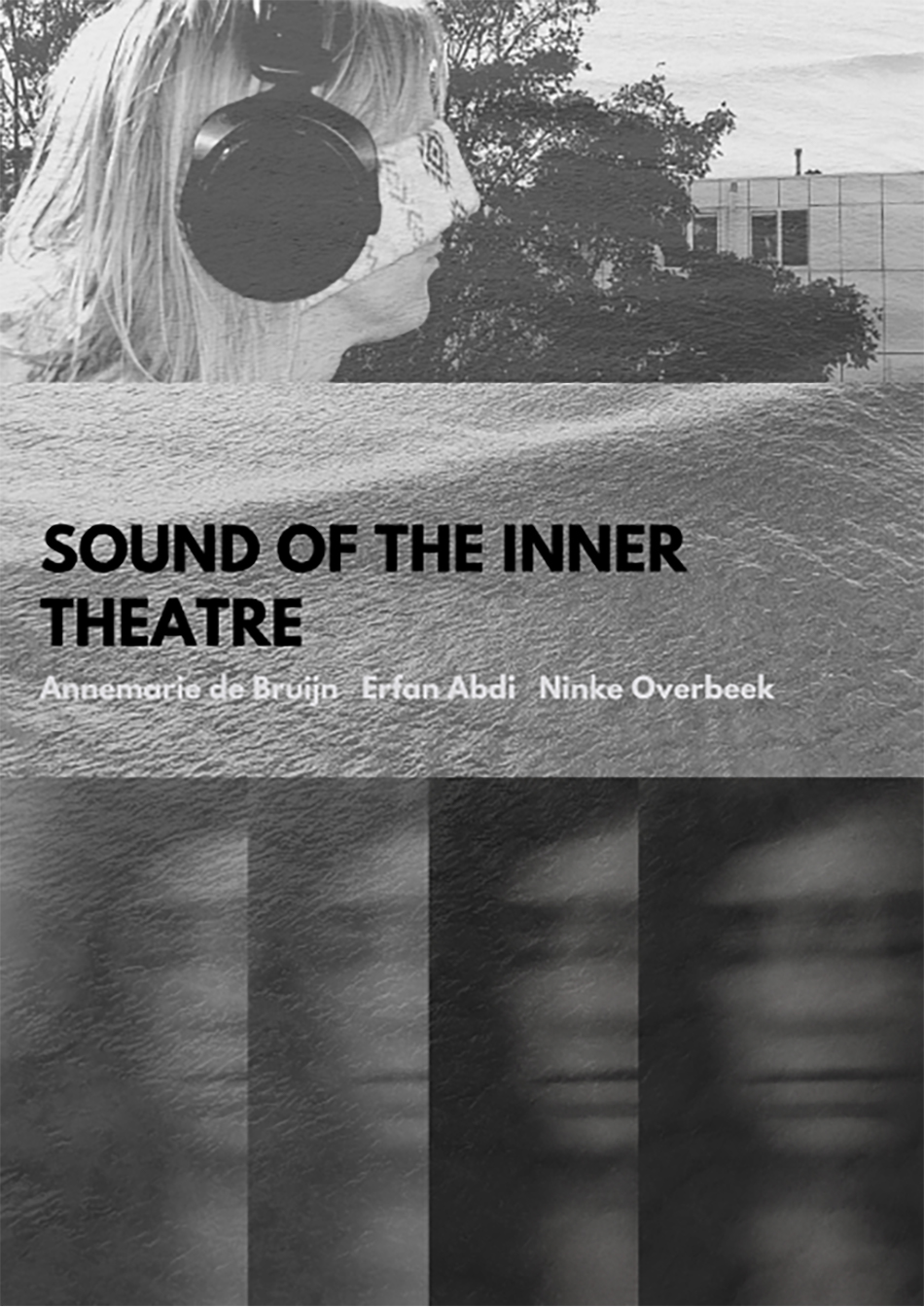diagrammatics
topology
performative diagrammatics
reading as creative practice
epistemic diversity
ethico-onto-epistemology
peer writing
embodied knowledge
let the body write
enquiry through writing
co-creating through writing
creatical writing
egofaketion
culturally multilingual authorship
third-space idiolects
écriture semi-automatique
language transition
invitation poetics
choreography as expanded field
writing as material practice
embodied language
writing and the senses
embodied knowledges
ficto-critical writing
poetry
new music-theatre writing strategies
The video is a companion piece to the chapter Language, Lips and Legacy: a Pedlar’s Life for Me, in The Creative Critic: writing as/about practice, Eds. Emily Orley and Katja Hilevaara, 2018.
The video and the chapter are examples of how I often pair e.g. written text with moving image work. Together they explore how writing in situ, as part of an artistic practice, can oscillate between monologue, dialogue, essay, poetics, reflection, research and documentation, within a space that hovers between subjective and objective knowledge.
A key idea is that a subject can be revealed through simultaneous production of creative and critical text in the site of, and during, making that takes place in public and that includes audiences. The criticality inherent in a live process of exploration is described through consideration of the roles of the artwork, exhibition, embedded multidisciplinary gatherings and the artist’s live presence.
The question of authorship, when a text is the product of multiple voices yet guided by the artist, is discussed. The tension sparked in the rubbing-up of the private (artist producing herself through the public revelation of her subjectivity) and the public (artist in site with publics/participants) is addressed.
The beauty and worth of the non-linear is teased out, by looking at the use of the fragment in building towards a larger whole, stimulating the requirement of re-reading as a way of negotiating temporality, in direct contrast to the Academy’s adherence to linear writing as a way of acquiring and developing knowledge.
CREDITS AND LINKS
1. Language, Listening and Belonging, Tracy Mackenna, 2017 (00:04:27)
LINK TO MORE
Tracy Mackenna ±
How can I reveal a subject through the simultaneous production of creative and critical text in the sight of, and during making that takes place in public and that purposefully includes audiences?
Language leads my life and guides my individual and collaborative art practices. Performing language is explored in a series of situations, occupying and shaping sites, locations and contexts. Through ‘live’ writing publications are produced, and subjects investigated in public research studios. As embodied artistic catalyst, I have become the Creative Correspondent and The Pedlar, inhabiting characters to simultaneously enact and explore through staging and processes of creative encounter, employing and sharing a creative toolkit of self, voice, sound, drawing, writing, film, travel, learning, story and people.
Strategic approaches embrace negotiation, critical engagement, control-taking, resistance, subversion, failure, self-doubt … sustained over periods when cumulative research processes are formed through research-led projects, embedded in and responsive to a locality. At the heart of multi-disciplinary behaviour is a woman’s quest - activated through the female body - for the production of language-based practices in the habitation of spontaneity: nimbly flexing in real time to the shifting and multi-layered conditions of each encounter.
My aesthetics is that of the moving; the shifting, slippery, transitional, re-ordered, re-toned, that is later fixed and presented as sequence, through geographical mobility transformed in the space between fixity and presentation. The inter-temporal, the personal and general histories, narratives and memories that reference lived experiences sit side by side reconstructing narratives and re-claiming memories, navigating place and dis-placement.
The video explores my relationship with my mother and is a memorial to Giuseppina Salvatore (1933-2015). It is representative of a method I employ to produce moving-image work – walking and writing in situ – e.g. Walking towards myself / Camminando verso me stesso, slide-projection, 2016, (00:07:00), and Thirty Seven Minutes and the Smell of Turning Earth, 2018, (00:30:23) where the affective and multisensory aspects of walking and travel are revealed in relation to their ability to stimulate on-site experimentation in textual and image-based language processes that lead to artistic compositions.
In Jo, Josephine, Giuseppina and Tracy, visual flashes reveal connections in a five-decade long relationship between mother and daughter. Conditions of duality – Scots-Italian identity – are offered as glimpses through considerations of place, belonging and language. The path in the video lies between my grandparents’ villages of Collemacchia and Cerreto in the region of Molise, Italy. Repeatedly treading the same short ancestral route, walking as empathic movement and transformative experience enables and embodies a state of ‘becoming’ that is explored and revealed through writing, moving image, still-image photography, drawing and audio recording. The path is geological time, stratification nesting settlements that ripple through one another across Sannite, Roman and today’s peoples.
These video works invite us to inhabit a rupture, to contemplate the finitude of the world; the artist is constantly in dialogue with others in her roles as mediator and translator.
CREDITS AND LINKS
1. Jo, Josephine, Giuseppina and Tracy, 2016, (00:06:53) / Tracy Mackenna, for Tracy Mackenna & Edwin Janssen, The Museum of Loss and Renewal
LINK TO MORE
voice | vɔɪs |
noun
1 the sound produced in a person's larynx and uttered through the mouth, as speech or song
2 a particular opinion or attitude expressed 1
Associated Thoughts: Their words, my voice is an evolving practice, comprising live readings from various quoted sources connected through a single focus or theme. These performative readings invite the viewer to listen laterally rather than literally. Using the words of others to chart a path through my own thoughts, explorations, and ponderings, the work focuses on topics that are interrelated to my interests, yet spoken from a diverse constellation of quotations.
Others’ divergent words are linked together to create a constellation of new meanings expressed through my voice. Audiences are invited to listen and hear the line being ‘drawn’ (in)between the connecting points. My voice is expressly heard both in the sound produced when speaking the words and my voice particularly comes through in the expression of my own opinion(s) or feeling(s) through their words and the gaps/links between.
Weaving together a meandering line of associated thoughts, these readings explore new possibilities of understanding when situated together. Playfully creating and exposing links and interconnections between the quotes, and the spaces between, creates new meanings. In essence, this work is an experiential understanding of the interconnected points that are adjoined through others’ words, building new meanings for and through my voice.
1. Unknown. Voice | Search Online Etymology Dictionary. Online Etymology Dictionary https://www.etymonline.com/search?q=voice (2020).
CREDITS
1. Associated Thoughts on Line, 2019, live reading as part of Convocation: On Expanded Language - Based Practices within the Research Pavilion at the 58th Venice Biennale. (Photo credit, Katja Hock)
Danica Maier ±
I am interested in the un-repeating-repeat, material processes, transposition, conflating expectations, and how an audience (as a body) sees, looks, and listens to the work; as well as the dialogical nature of collaborative projects that foster independent works alongside wider group outcomes. I typically work with site-specific installation, drawing, and objects to explore expectations, disrupted repetition, and line. More recently I have viewed my practice akin to a spider’s web of intersecting threads, each tether of the web a different interest and/or material/media yet still interlinked. The tethers that specifically relate to Language-Based practices are seen mainly through two distinct outcomes: drawing and performative readings.
Drawings are created from a single repeated word forming a decorative yet subversive work. These works are a playful compilation of words and pattern sitting at the intersection of language and visuals, both present but not always ‘seen’. Playing with colloquial understandings of terms, once read/seen they fold back into and bring further consideration to what was initially seen.
More recently, I have begun playfully bringing together a constellation of new connections and understandings through live readings of quotes. Using others’ words, these live readings are drawn from a diverse set of references - from philosophy to children’s popup books, from fiction to technical manuals. These readings guide you through a lateral journey in which I invite the listener to hear the connected thread and the new voice brought to and between the diverse texts and the gaps between.
An ongoing drawing-based practice, explored over 20 years, in which a single word or phrase is repeatedly drawn/written creating a decorative yet subversive work. Oscillating between text and image the repetition of drawn words transforms them into the visual while still maintaining their linguistic meaning. Like calligraphy, the textlines within the drawings are intended to be visual while retaining moments of legibility. The artwork unfolds slowly to the audience, only revealing its true nature (words) once time is invested in looking/reading.
Pattern and line accumulate and build into words, repeated over and over; words and letters dissolve into pattern, repeated again and again. This writing-as-drawing flips between the visuals of the drawn word and the word’s meaning; once seen/read the textlines collapse back into the imagery of the drawing. This folding back of words into the pattern creates new ‘readings’ and understandings from what was first seen/experienced. Like a fractal process of zooming in and out of the work, the viewer steps back for the long overview, moving closer for the individual view, further in for a detail view, back out again and so on.
The action of forming letter shapes and word forms is a slow, meditative, and repetitive activity. A time-consuming process of repeatedly drawing/writing a line, a letter, a word; this slow action of making is embedded and seen within each work. Focusing on drawing a single letter annexes if from the word, dispelling meaning while building new interwoven meanings between image and word, word and expectation.
CREDITS
1. Mossy Rose, 2011, pencil on mylar back mounted onto aluminium. (Photograph: Danica Maier)
Cristiana de Marchi ±
My practice explores social and political terrains, from memory, places of the past and present, identity and contested borders to the paraphernalia of contemporary nationhood. Using textiles, embroidery, film and performance, I instigate processes that draw attention to currencies of power by exploring their structures.
These systems are interrogated by extracting the signs and symbols that constitute them. I lay bare the power latent in flags and their colours, passports, places, statistics, sociological models, words and letters. Focusing on often-overlooked details, attention is called to how the apparently innocuous every-day are the essence of larger structuring schemes.
Having seized on a sign, I distil it, breaking it down into constituent elements through repeated and cyclical processes such as stitching and undoing or filmed transformations such as ice becoming to water and inflated balloons progressively expanding and bursting. Each process, each work, revels in the potential of progressive transformation. Words are physically expanded to bring focus on each letter in turn, suggesting the invested power of their signification. Flags are drained of colour prompting renewed consideration of their insignia.
These motions deconstruct symbols and ideas to open spaces for contemplation. By enacting subtle alterations, the inherent power in extrapolating symbols from their ordered and overlooked structures is demonstrated. Deconstructing and reconstructing, attention is drawn around the potent potential of re-cutting, repurposing and repeating.
The Commemorative Stamps series consists of fabricated sets of stamps either created out of litter that I collect in my urban peregrinations or entirely fabricated based on online sourced and imageries pertaining specific research fields (such as capital punishment and environmental justice). The stamps are then activated and used for fictionally posting series of letters addressed to the representatives of a number of pertinent governmental ministries and institutions worldwide, thus referring to issues of information's dissemination and dialogue between the public base and the power, and the possibility of solutions being circulated from the constituent base of society.
Just like the stamp itself cannot grant free circulation to the letter as it is not emitted by an authorized agent/government, so do my words (contained in the letters or transcribed on the postcards) thus highlighting citizens’ individual struggle to affect major political decisions, or even to be heard.
At the same time this whole process of fictionalising the correspondence creates a space for freedom, where the transformation of mundane and dismissed objects into stamps and the very act of naming the responsible institutions and making them accountable authenticates, validates and empowers the dimension of an otherwise inaudible citizenship.
Finally, a further element of interest, as it comes to my artistic research, lies in the contamination of registers, in the crossing of different languages, in the exophonic nature of the experiment: not only I adopt a language – English – which is not my mother tongue and which I possess with various layers of approximation; but I also combine visual and verbal languages, thus exploring areas of discomfort and adaptation – or refusal/denial of – to a position in society which is elusive and highly impermanent for many of us.
CREDITS
1. Cristiana de Marchi, Commemorative Stamps
2. Cristiana de Marchi, Commemorative Stamps
Performative Topologies (2018/19, ongoing) proceeds from a short list of seven, carefully worded prompts, delivered by an initial, core facilitator. Current facilitators have contributed to the creation of the project and are intimately familiar with its steps. The prompts evoke a memory of an object, leading into personal narration, followed by informal individual and considered collective movement that is brought about by collaborative conceptualization.
Performative Topologies is a facilitated action sequence. It is supported by a video feedback projection using topologically modified 360-degree video. Facilitators guide small groups of participants into performative experiences that validate own perceptions, generate a doubling of presence, and lead to the modeling of shared, diagrammatic space. Validation of own perception and experience is crucially connected to participating in "affirmative alternatives to the dominant vision of the subject" (Braidotti), and enables "infra critique" that allows "worlds to emerge in collective action" (Verran). A doubling of presence is described by Brian Massumi as "a resonation or interference pattern", a rise in intensity he connects with Spinoza's parallel activation of mind and body. I conceptualize these activities as co-creating diagrammatic space, understood as topological. This exceeds conventional treatments of the diagrammatic as two-dimensional, allowing for added dimensions and qualities of relation. My overarching desire in opening up such a resonant, diagrammatic space is to find new ways of experiencing the polyrhythms that arise when enacting the dance of epistemodiversity (Clavo). (From a text currently considered for publication in the International Journal of Performance Arts & Digital Media.)
CREDITS AND LINKS
1. Image from Performative Topologies
Adelheid Mers ±
First, I am a reader who attends to the doing of taking in. What are the operations my mind performs when it encounters a narrative? For example, it segments a linear text and rearranges it on a plane or in a space. As someone who speaks, I experience linguistic relativity as a liberatory concept. This is the idea that the grammar of the language one speaks and one's perception of the world are intertwined. If my mind is preconditioned by the grammar of my first language, what lies below that, and what beyond? This thinking opened the doors to a lifelong focus on epistemic diversity. In part to live in a second language, outside of my initial conditioning, I leveraged a grant to emigrate from Germany to the US, in 1988.
Throughout, I have entered into my work through parallel, spatial and language trajectories. Between 1980 - 1995, I worked out what in retrospect I understood as an implicit diagrammatology, or forms of visual reasoning, building modular structures and immersive light installations. From observing audiences, I learned that their uses were choreographically embedded in these works. Adjacent teaching and curatorial projects were opportunities to work out a performative approach to arts ecologies, the ways artworlds are organized, which also led to a professorship in Cultural Management.
In 2000, I explicitly established a diagrammatic, artistic practice, visualizing texts, presenting lecture performances with prepared Whiteboards, and live mapping lectures by others. In keeping with my readerly inclination to observe how I practice, it is my experience as an artist who also speaks and writes about my work that language arises from attending to doing. I visualize this as an emergent topology, a space that stretches and bends, but cannot be cut. it is interesting that 'to cut' is the root word for 'critique'. In studio conversations, I regularly experience forms of criticality that unfold more than cut. From this premise, I led conversations with colleagues about their research and art practices, charting 'epistemic engines', personal ways of knowing and making sense, in good part to aide forms of affirmative criticality to evolve. Through a great number of those chartings, meta diagrams emerged around 2011 that can similarly serve general audiences to unfold own, embodied ways of making sense. Under the heading of Performative Diagrammatics, I currently facilitate uses of these 'diagrammatic instruments' with individuals or groups, and also continue to co-create new instruments in Performative Diagrammatics Laboratories.
In 2016, I was pointed to Karen Bard's writing, with the challenge to diagram some of it. The following narrates how a formal, visual solution I devised in creating a diagrammatic sketch of Karen Barad's proposal to place intra-action at the center of a new, onto-epistemological world view subsequently evolved into the diagrammatic BRAID instrument. The stream that fed into the BRAID instrument was a long series of conversations with artists, initiated with the intent to support artistic identification of own epistemes, through conversations about making that are not object centered.
The BRAID became a diagrammatic facilitation instrument that invites artists and other cultural practitioners to think through own ways of working, particularly through dialogue among paired users. The Braid diagram shows a torus traversed by a trefoil knot, its three loops labeled Making, Mediating and Managing. Guided by a facilitator or using a brief, written introduction, actions with the BRAID and its auxiliary objects include listening and observing as much as speaking, writing, drawing and moving. The diagram is a significant part of, but not the full, diagrammatic instrument. Scale, type of substrate, mounting method and placement of auxiliary objects are equally important. Moreover, the BRAID instrument functions as part of a carefully orchestrated, flexible setting - an installation in a gallery, a space prepared to host a workshop at a conference, or my studio. Within the setting, users may find themselves drawing systemic, perhaps ecological conjunctions among parts of practice previously perceived as only loosely connected. (From a text in press: Mers, Adelheid. The BRAID: moving across dimensions from representation to performativity", in: Birte Kleine-Benne, Elke Bippus, edts.; "Dispositiv Erkundungen, jetzt.", Logos Verlag, Berlin. expected 2020)
CREDITS AND LINKS
1. Documentation of The Braid
An expanded typing project (KYBDslöjd) produced with the Bilbaoarte Fundazioa Sudio & Production Grant in 2018. A six months residency who was materialised in a Performance, an Installation and an Artistic Practice Research article. A brutalist storytelling about technology and keystrokes using a Commodore 64 computer.
KYBD is the acronym for keyboard, where a drawing or an animation is typed in by using different keystrokes for each mark on the screen or the paper. The word Sloyd (Swedish, Slöjd) is derived from the Icelandic and means dexterity or skill. In old Swedish, we find the adjective slög (artistic or skillful). In KYBDslöjd, hardware and software are a challenge, they are not decorations or sources of nostalgia. There is a narrative, a dialogue with the technology. In KYBDslöjd, the screen is the canvas, a rectilinear grid on which one keystroke at a time build a character-by-character imaginary. It is brutality itself because it reveals what it is and what it does without adornment.
KYBDslöjd is not only a type in method, but also a system of text characters (signs). It is a straightforward language based on keystrokes. Like in ‘tangram’, you have to use your imagination to assemble the characters.
“I’m here [for now]” uses a particular way of working with keystrokes and PETSCII on the Commodore 64 with software developed by Mathman (Johan Kotlinski) called Nop. The program consists of two parts: a block of data statements containing the instructions where all the keystrokes are recorded and a section of code which reads in the data and outputs it as an animation and speeds it up. There is no menu, so all the instructions, like color, position and character shape, are typed on the keyboard. Only a black screen with just a blinking character is waiting for you to do something.
This is the starting point, like a blank sheet where you are alone and no one else is to blame. Not even the technology for being obsolete. This is how the live performance “Trueno” was done.
The expanded typing version of “I’m here [for now]” is the sculpture built with CNC named “Woodscii”. It is wordplay between the PETSCII character set and the material used it for. The piece made is a totem that ironizes our faith in technology, since we make it responsible for everything good and bad that happens without taking any responsibility about.
CREDITS AND LINKS
1.-2. Performance Trueno (2018)
LINK TO VIDEO
LINK TO TEXT: Keys of Fury:Type In Beyond the Scrolling Horizon
LINK TO TEXT: I'm Here (For Now)
With a teletext character we can build everything we want without falling into excess, an openended form of defiance against reassurance. ‘Inattention’ started as six teletext pages for the exhibition ‘ORF TELETEXT trifft Kunst’ at Ars Electronica 2019. In 2020, the project expanded to a Teletext- based animation made at the Residency Irudika 2020 and, it was finished in confinement on May 3, 2020, in Angoulême. Teletext is not a physical object; it is the dark band dividing pictures horizontally on the television screen, used by the PAL system.
Vertical-blanking-interval lines like REM (rapid eye movement) sleep intervals. A door to unlock the Imagination. A message in an unknown language that we are still learning and have so much to say. The future doesn't need us, reason and life submit to the ferocity of financial mathematics, algorithms and technology. What awaits us is a techno-medieval version where all stored knowledge will be reduced to premium access or simply disappear leaving the cloud in ruins for us.
The Internet is destined to collapse but its legacy will become an aestheticized version for contemplation, a full-blown ruinenwert. Humans will be reduced, rather than to relics, to techno-rubble. It will cost us a lot not to end up as the Anthropocene’s debris, but we can still resist.
Teletext is a news and information service in the form of text and graphics, transmitted using the spare capacity of existing television channels to televisions with appropriate receivers. What the viewer sees on the screen of his teletext TV is a page of characters, 40 in a row, 20-24 rows, 800-960 characters per page. These characters can be presented in a limited number of colours, including coloured backgrounds, and the character set contains all the letters of the alphabet (both uppercase and lowercase), numbers, punctuation marks, special symbols, and graphics. Teletext is a silent medium, as there are no narrators, but users must read the information from the television screen, transforming the characters with their imagination.
CREDITS AND LINKS
1.Still from Inattention.
2.'Inattention' created at the Residency “Irudika - Acción Cultural Española, AC/E 2020” at Fundación BilbaoArte Fundazioa (Bilbao) & La Maison des Auteurs (Angoulême), 2020.
3.‘Inattention’, ORF TELETEXT meets art, Ars Electronica Center, Deep Space 2019.
LINK TO TEXT - Is It Just Text?
Raquel Meyers ±
Raquel Meyers is a Spanish artist who defines her practice KYBDslöjd (mecanografía expandida) whose significance can be defined roughly as <manual skill with a keyboard> that materializes the text characters and the typing on a keyboard beyond the screen and questions our parasitic relationship with the technology. It is not a mere arbitrary intervention. It is based on and refers to the typewriter, Concrete Poetry, Demoscene and Brutalism. The typewriter contributes to the execution, while poetry contributes to a system, a brutal language that should be learnt. The characters are used without ornament like concrete in brutalist architecture, capturing the spirit and the contradictions of its time. She belongs to a generation which, above all, has been electrocuted by technologies. Irony and Cynicism seem to have taken us to a precarious state: acceptance and resignation. The tyranny of easy to use and immediate satisfaction are just deterrence methods that are bringing us to the dump and to boredom. We live in a digital era and no one is free from paradoxes. She works with the so-called obsolete technologies like Commodore 64, Teletext, Typewriters, Embroidery or Fax.
Elina Mikkilä ±
I engage in an innerdisciplinary form of practice-based literary research at the interface between prose writing, comparative literature and paratextual mise-en-scène.
My practice involves an amalgamated kind of epistemic-aesthetic writing that I term ‘creatical’; the portmanteau word highlighting the innovative hybrid character of this type of authorship. It aims to exceed the sum of its creative and critical components, be it in the form of metatextual, poetological or theory-endowing insights. This endeavor recalls the theoretical-creative writings of the French post-structuralists that, for their part, grew to be of interdiscursive significance.
Border crossings also characterize my literary idiolect as a non-native creatical researcher. Owing to my repeated linguistic-cultural, geographical and discursive changes of perspective, I have adopted a meta-perspective. Missing fixed attributions, my practice involves a number of paradoxes that I prefer to view as a permanent source of creative friction rather than as dichotomous oppositions:
- My linguistically decentralizing appreciation of the slowly emerging practice-based literary research runs counter to the linguistic purity requirement in literature that assumes a particularly high command of one language.
- In me intellectual-hermetic language-centricity oscillates with a post-postmodern form of writing which combines canonical narratives with the culture of the mass media.
- As a freelancer researcher I make a neoliberal pact with the economic field in our supposedly knowledge-based society.
With the idiolect resulting from these queer connections, I question, as a ‘serial border crosser’, the blind habits that shape our monolingual text reception. My practice seeks for a multilayered understanding in accordance with our pluralistic life world.
My on-going experimentation with linguistic multiplicity started with a series of workshops held in diverse international and interdisciplinary settings. For this purpose, an excerpt from my autofictional prose narrative Mütter Land was translated into the participants’ mother tongues by an online translator. Since the original piece was written in dense literary German, the digital (re)translation process rendered highly unpredictable interlingual outcomes. Thereby the excerpt metamorphosed into a moving body of meanings (performatively illustrating Derrida’s deconstructive reading strategy « différance »).
In my literary writing this self-imposed linguistic restriction works as an innovative catalyst. Similarly to the experimental constraints practiced by the French avant-garde literature group OULIPO, my approach to language is, like that of most non-native authors, characterized by experimentation. The more complex the relationship between the signifier and the signified, the more surprising the resulting associative richness.
Centered around a concept of the multicoded literary language that proliferates in the (postcolonial) hybrid “third space”, I mix practice-based and theoretical approaches to address questions related to multi-idiolectal identity formation:
- Literary exegesis: Which new meanings are produced, which emotional connotations or linguistic subtleties are lost in the process of (transcultural/-disciplinary) translation?
- Ecriture ‘semi’-automatique : What associative manifestations of the unconscious are produced in the course of linguistic metamorphosis?
- Qualitative research: In what ways does the experience of not understanding fuel feelings of disorientation and deracination and/or increase the creative and empowering potential of minority discourses?
- Knowledge-endowing montage: How do emerging associative arrays challenge dominant beliefs, structures and (‘pecking’) orders?
An example showing the creative non-monolingual meaning-making process can be found under the heading ‘Babble, Babbel, Babel’ (p. 91-93) in Mikkilä, Elina. 2020. “Literary Biographies Without A Fixed Linguistic Abode”. In: Folklore: Electronic Journal of Folklore. 79, p. 91-114. https://doi.org/10.7592/FEJF2020.79.mikkila.
LINK TO TEXT:'Babble, Babbel, Babel'
Daniela Moosmann ±
WRITING IS RESEARCH IS WRITING
My vision on writing is very much grounded in my past as a dancer and a theatre writer. And so is my artistic research. Based on that background I believe in embodied knowledge as much as in reflection through writing, in the insights and use of writing processes and theatre making processes, which inform the research process. The key concepts of my research are the reflection and knowledge of the unconscious and conscious, the use of dialectic and peer-writing as an entrance to artistic research and its dissemination.
When we do artistic research we all come to the point where we want to articulate our knowledge that we want to share in words or at least in a dissemination form that allows others to tune into your thoughts and participate on the reflections and conclusions of our researches and inquiries. Many artists, whether they are academically formed or more anchored in the artistic practice struggle with how to do this.
I am convinced, that there are easy and smooth ways to get contact to the own wisdom – through freewriting methods as well as freetalking and peerwriting methods.
- Talking is the first step of writing and will improve your writing;
- Writing is the first step of reflection and will improve your talking on an issue;
- The body is the entrance of your knowledge;
- Your conscious will give you more information than you knew you know;
Writing fictional and non-fictional dialogues as single or as peers can enfold more reflection on that knowledge.
Work of authors that influences me are among others:
L. Richardson, Judi Marshall and ethnographic writing practies as well as ficto/critical strategies, Jonathan Wyatt and of cause also and still Peter Elbow.
Research focus: contemporary playwriting processes and the use of writing strategies as research methodology in Higher Art Education. I am a core-member of the research group Beyond Freewriting: Writing and Research of the Professorshop Performative Processes at HKU Utrecht University of the Arts. The research group explores the ways in which both artistic research and artistic practice can be disseminated in writing.
The use of writing strategies as research methodologies in Higher Art Education
Before the artistic research has started, the art students write down everything they know and want to research about their subject in a freewriting session. This includes theories, sources, examples from their own practice and examples of work of others. They hand this text over to the next student, who reads everything and writes comments, advice, tips and thoughts in the texts’ margins and in the source-text. This iteration is repeated a few times and every time the next student (a different one) reacts to every text that is written on the paper.
Lastly, the original writer gives another written reflection on all texts written about their research. Purpose of this exercise is to stimulate free and divergent thinking, to find and embrace unexpected connections within the research plan and to work and research dialogically.
In my research, I make the connection between writing and doing research. Which strategies can be found to do research through writing and to experience the interaction between doing and thinking, between embodied and other knowledges.
Purpose of the research is
- To find concrete and practical exercises that connect all these elements.
- To deepen the content of the research.
- To improve the verbal and written reflection on the research.
- To generate texts that can be part of the artistic product.
Key words are: peer writing, embodied knowledge, let the body write, enquiry through writing, co-creating through writing, writing to enhance verbal communication on the research subject.
CREDITS
1. - 4. PEER WRITING STUDENTS BA THEATRE AND EDUCATION, SEPTEMBER 2020
Since 2018 I collect memories to dance. In an obsessive journey of conviviality, choreo / graph invented memories as a series of language materialisations. Set as one on one relational episodes, the work is situated on to specific spaces of encounter between the narrator (audience member) and the narrative (dancer).
Within choreographies of telling, reading and hearing, the memories are embodied through voice, inscription and movement. Rhythms, (s)pace, repetition and minor gestures are captured in-between voice and skin, gesture and ears, sound and paper. By posing a choreographic listening, I dance with my typewriter which, by writing, prints a choreography on-page. For each choreography, a dance from artist to the audience or, maybe, between artist and audience.
Envisioning to create spaces for togetherness, the work plays with the idea of authorship, collaboration, choreography and dance by waving place and duration of memories themselves. Despite one might relate memory as a revisiting of the past, or may understand its active creation towards the future, with this piece I acknowledge the present-ness of embodied memories by dancing them. It is a choreography that relies on the active knowing embedded into responsive, malleable and transient structures of the relationships between people and their narratives.
The felt sense of memories, materialised as dance on paper and on-site, are a continuous yet ephemeral becoming that may be set, and transformed, by the site it occupies. So far, the work has been performed on streets, corridors, stage, art galleries and audience’s houses.
CREDITS
1.- 3. Choreographies (of the memories I invent not to miss what I didn’t live)
Janaína Moraes ±
As a dance artist, I am interested in choreographing language. It is being a migrant artist, though, that has been compelling me to ask how the notions of displacement and transit can shelter my practice. Three specific notions reside as a soft structure for my investigations to live in: language transition ∞ art(...) residenc(...) ∞ invitation poetics. Language transition is an alternative to the idea of translation which privileges the embodiment of slippages, co(n)fusion and invention as potentialities for togetherness to enact. Autonomous yet interconnected, language transition informs and transforms my understanding regards choreography, community and temporality, spilling into the situations held as art(...) residenc(...)s within an invitation poetics.
Performative writing, writing as a material practice and language as a means for choreographic be(com)ings are some of the procedures that spiral and rearrange contexts for this research to happen. Therefore, writing, reading, talking and listening are some of the choreographies that act out as invitations to engage in poetics of dance as a relational practice. Language becomes the very dance and choreography opens itself up to the expanded field, taking part in journals, lectures, conversations, audience’s houses, community centres, streets and so on.
Transitions occur as a strategy to perform unsettlement through (made)aware kinaesthesia. They are (extra)ordinary appearances that engage in poetic image-in-action within a situated context. It sometimes appears as the change of named languages (Portuguese, English and Invention) in a conversation; as the coexistence of ‘formal’ and ‘informal’ styles occupying the space of academic language; as slippages of performance in a specific context; as disruptions and/or reinforcing enactments. The paradoxical nature of language transitioning, moreover, activates a constellation of activities in which ending points are found to be the starting points of what ‘it-already-is’ and what ‘is-yet-to-be(come)’.
The writings in the diaries and notebooks became typewritings that became lyric scripts that became spoken and sung works that became installations and encampments and encounters. This text became a collaborative work in which singer Mariske Broeckmeyer was invited to use the Notes as material for a sung work. In the exhibition Alias, the work was installed as a quadrophonic sonic sung work in the tin cabin set up under a matriarchal Ginkgo tree. Exhibition Alias, Netwerk Aalst, Belgium, 2019.
CREDITS AND LINKS
1. - 3. Wendy Morris, Travelogue of the Wandering Womb: Her Fantastic Encounters and Curious Utterings. Notes for a Work
Wendy Morris ±
Specific to my current artistic practice are Libraries, Diaries, Letters, Typewritings and Travelogues. With 45 notebooks on the shelf since I started and defended a PhD, and the 52 letters that emerged from them, with 7 years of attentive diary-keeping that have resulted in 28 red notebooks, with 11 cloth-covered project notebooks focused only on the current investigation that started two years ago, with the Radiobook, the Audiobook, and the one for Muriel, my Emissary to the Past, as well as the logbooks and herbaria… my studio resembles a scribomanic’s library. So much writing, every day, every thought. A day unnarrated is a day unreflected. A thought unwritten is a thought potentially lost. Then, there follows a second wave of writing. Typewriting. On the bright-green Remington Concord, or the office-green Voss, sometimes on the creamy Brother or the beige Erica, I typewrite. Blue carbon paper inserted between pages. The notes and narrations change register. Ideas are chopped up and tossed together. Attention goes to rhythms and repetitions. Typewriting hands make mistakes and the mistakes are integrated into the text. The hands type, the ears listens, the mouth begins to utter, mutter, to form sounds. The typewritings become scripts, scores, broken lyrics. Libraries, diaries, letters, typewritings, mutterings, whisperings, audio-eeries, spoken prologues… a continuous re-organizing of words until the moment of pleasure when the words and phrases and paragraphs – suddenly - zing.
'Three Orange Trees. In the future.' Solo Storytelling Performance: 25'-30 ́ is a storytelling performance, that uses several methods in order to explore how one looks at, analyses, describes, memorizes and verbalizes an event/process and/or story in time and in space. At the same time, it explores ways to intervene in its dominant narrative in order to transform it, by creating alternative ways to look at it. With the intention to move from the 'personal' to a more 'collective understanding', within this practice, I worked with the notions of the 'care of oneself ' linked to the Stoic philosophers and their practices, as described by Michel Foucault in 'The Hermeneutics of the Subject' .1
The Stoics proposed several practices/askesis/exercises, which were meant 'as a development of the culture of the self' , and were described in different philosophical writings of the Hellenic and Roman period. These exercises, had to do with how one should look at (analytically and in its totality) an object , an event, and one's own self and life, how important it is to describe what you see and verbalize it to one's self and to others, and how to memorize what you see in time and in space. I used some of these exercises/practices almost like a choreographic score, and I applied them as transformative mechanisms within the self fictions.
1. 'The Hermeneutics of the subject',1981-82, Lectures at the college de france, Palgrave McMillan
CREDITS AND LINKS
1. 'Three Orange Trees. In the future.' ArTEZ University of the Arts, MA Theatre Practices, June 2019,
Image Credits: Fenia Kotsopoulou
2. – 3. 'Three Orange Trees. In the future.' Volumes Art Publishing Days '19, 29.11.2019- Kunstahalle Zurich
Eleni Mylona ±
Writing, describing, speaking out loud, and performing autobiographical narratives in order to create alternative fictional scenarios, is at the core of my research. Language is the main compositional tool I use, through which imagination is activated in order to transform the narratives into micro choreographies/fictions of mental movement. The action of intervening and transforming the initial (autobiographical) story is, apart from a way to confront and deal with my own precarity, also my proposition on how to converse with the social and the political. The socio-political proposition that emerges from my work is to create a social and public space, where engagement with imagination can happen. In that space, events are placed out of their spatial and temporal contexts; they move away from the personal and towards the relational and the public (in the world). Narratives are understood as open-ended.
Furthermore, language within this research has substituted body movement, and body expression, in order to give space to all the possibilities language and imagination can offer, like the movement of thought, stillness, and mental motion. My definition of choreography is related to concerns about the 'self' and the 'other' that are exposed through language in thinking, in writing, in speaking and in performing.
'Me and a fly in an empty studio' explores the possibilities of language and imagination, by proposing to make a choreography with only one sentence. It plays with how this sentence works when it is written, voiced and heard, in different ways, what does it construct, how and what it creates when deconstructed.
Imagination works in favor of opening different spaces for perception for the audience. Here, language is used as rhythm which is one of the ways I explored as a choreographic method, as I don't aim to create meaning by representation, but rather meaning is constructed through rhythm and the use of it.
In terms of content, the text alternates between the proposition of the aforementioned imaginary choreography, and an autobiographical narrative, within which I describe the struggle of my early years to come in terms with the competitive logic of the market. Here, a tendency towards an ethics of 'care', in which process is valued more than the end product, is evident.
CREDITS AND LINKS
1.Extract from Me and a fly in an empty studio
LINK TO MORE (See pages 13 -20)
Ninke Overbeek ±
My work as a writer, dramaturg, researcher, and teacher is focused on language and revolves around a translation between the autobiographical and the poetic. I am currently taking some new steps in my research work, which means you find me and this application in the middle of a development stage.
I am preparing a PhD proposal, in which I aim to focus on a translational process (to be further specified; transposition, translation, transcreation, metaphoric relations are to be explored) from autobiographical material to poetry or the poetic. What does the change in the shape of the lens inaugurate/ make visible. Does it help to connect to another person’s frame of reference. Does it help connect to another person’s body. What does the shift mean. What happens when the translative process becomes performative; from written on the page to performed as auditory or filmed material. What does the poetic layer mean, what does it bring to the material.
My practice exists of my own texts (often poetic and performative) that are shaped into installation and performance pieces. I work with language-based artistic practices as a teacher, as a dramaturg and as a researcher. The writing, in this case, is a method to work through certain questions about language, physical experience, metaphor use, silent or tacit thought-processes.I am a core-member of the research group Beyond Freewriting: Writing and Research of the Professorshop Performative Processes at HKU Utrecht University of the Arts. The research group explores the ways in which both artistic research and artistic practice can be disseminated in writing. Research focus: ficto-critical writing and connections to embodied knowledges.
In my research, I combine writing strategies which are focused on sense-perception, with conceptual metaphor theory. I explore this kind of writing as a strategy to inaugurate knowledges from deeper physical and subconscious levels.
Key words: focalization (M. Bal), freewriting, writing and the senses, embodied knowledges, ficto-critical writing, interdisciplinary writing strategies, poetry, new music-theatre writing strategies. The research is done in my own writing practice and in the writing classroom.
When I teach, I tend to explore possibilities of focalization/ lenses/ ‘perspective’ through writing. I worked with these strategies at Webster University in Leiden. First and second year students from a humanities course (BA) were asked to do a series of freewriting exercises. I let them read a short excerpt from Mark Johnson’s The Aesthetics of Meaning and Thought (2018), and I asked them to freewrite in relation to an object first: a cup, a bunch of grapes. They are asked to focus on sensuous perceptions: smell, taste, touch, sound, vision. They freewrite and discuss together what is provoked through this type of writing. Then, I give them a similar exercise, but related to an idea or concept. ‘A comfortable place’. ‘Being at home’. After a few of these exercises, they are given the task to write with a similar technique, in reaction to a more academic text. In the past, I have used work by Judith Butler ‘Politics, violence and mourning’ and by Jean Luc Nancy: ‘L’Intrus’. Purpose of the exercise is to help students connect the more abstract concepts from such a text, with their own subjective perspectives.
Purpose of the larger research is to find a way to (re)connect sense-perception and conceptual knowledge, to enhance students’ connection to and understanding of the academic texts they read and their own subjective engagement with the material. Within an artistic practice, this type of back and forth between conceptual thought and working with sense-perception, is a way to utter voices coming from within ourselves. It also possibly voices knowledges that operate between what can be felt and what can be known.
CREDITS
1. WRITING EXERCISE WITH AN EXCERPT FROM JEAN LUC NANCY’S ARTICLE ‘L’INTRUDER’
I am currently working on a digital auditory piece, in collaboration with Erfan Abdi (sound design), Willemijn Haasken (voice actress) and Annemarie de Bruijn (director). We experiment with binaural mics and explore if and in which ways we can create an experience in which the audience feels as if they step into the mind of someone else. I wrote a (poetic/ metaphoric) text; LIMBS, in which a person who exists of three inner voices, travels through a variety of (inner) spaces, while being slightly out of touch with their own body. We aim to research how we can shape an auditory experience around this text. Which spaces can we create through sound and specific voice-interpretation? Can the language and the sound connect to the audiences’ physical experiences? Can we create recognition through such an experience?
CREDITS
1. Promotion for LIMBS, a digital auditory piece, in collaboration with Erfan Abdi (sound design), Willemijn Haasken (voice actress) and Annemarie de Bruijn (director).

